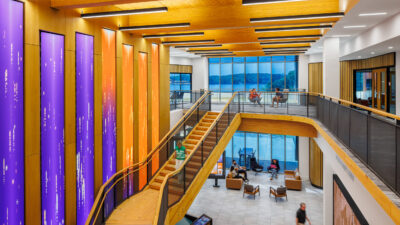When fire gutted the building that houses Pratt Institute's School of Architecture, it left a roofless brick structure—and a unique opportunity. Rogers Marvel Architects was hired to design the reconstruction of Higgins Hall on the Brooklyn, N.Y., campus, creating contemporary classrooms and studios while preserving character of past construction, including arched openings, timber lintel...
When fire gutted the building that houses Pratt Institute’s School of Architecture, it left a roofless brick structure—and a unique opportunity. Rogers Marvel Architects was hired to design the reconstruction of Higgins Hall on the Brooklyn, N.Y., campus, creating contemporary classrooms and studios while preserving character of past construction, including arched openings, timber lintels and curved masonry.
But the original Higgins Hall was not designed for the wiring of a contemporary computer-oriented design process. “In order to turn a shell of a century-old building into a 21st century architecture school, you need new mechanical and electrical systems, including wiring and data cabling,” says Rogers Marvel’s Guido Hartray. “And you want to contribute to the architecture, rather than add clutter.”
To route wires and cables, the firm specified a perimeter wire and cable management system that has two channels—one for power and the other for communications. In classrooms, the raceway was installed in a band running below large pin-up surfaces. “It allows us to distribute power and data in a way that can be part of the architecture,” says Hartray.
Surface raceway also provides the flexibility to relocate receptacles and communications jacks to suit changing needs. An example is open studio spaces where students have their own desks. “It’s almost like an office setting in a big loft, except that it changes every three months with the academic calendar. The perimeter raceway gives students freedom to move things around and set up their desk to their preference,” Hartray explains.
Hartray believes that Higgins Hall has successfully fulfilled its design and educational objectives. “We used exposed materials and systems to reveal the structure of the historic building and the new interventions within it. The raceway takes care of power and data requirements but is also a design element that defines the perimeter of the space,” he says. “Students can see it and better understand systems like power and communications—and the relationship these systems have with the building.”
The reconstructed Higgins Hall has received numerous honors, including the National AIA Honor Award, the New York State AIA Award of Excellence, the New York City AIA Honor Award and the Interiors Award as Educational Facility of the Year.



